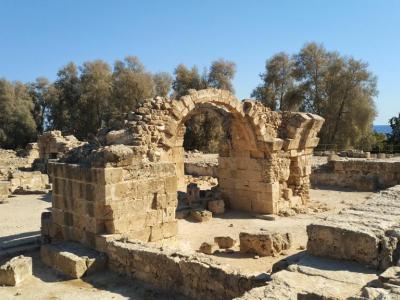Saranta Kolones (Forty Columns Castle), Paphos
In the heart of the Paphos Archaeological Park lies the intriguing Forty Columns Castle. This medieval fortress is steeped in history, and its evocative name is derived from the numerous granite columns discovered on the site, which are believed to have once graced the ancient agora.
The story of Forty Columns Castle begins in the late 7th century AD. It was during this time that the Byzantines constructed this formidable castle to serve a crucial role: to protect the bustling port and the city of Nea Pafos from the persistent threat of Arab raids. Standing tall, it was a symbol of defense and resilience in the face of adversity.
Over time, this Byzantine stronghold experienced a series of transformations. The Lusignans, known for their architectural prowess, undertook its remodeling, further enhancing its defensive capabilities and grandeur. Forty Columns Castle was an imposing sight with its three-meter-thick walls, crowned by four massive corner towers and an additional four intermediary towers positioned along the joining walls. A protective moat encircled the castle, and access was granted through a sturdy wooden bridge that spanned this watery barrier.
Stepping into Saranta Kolones reveals a square courtyard measuring 35 meters in both length and width. Here, a tower graced each corner, a symbol of strength and resilience. The main entrance, however, lay on the east side, guarded by a fifth horseshoe-shaped tower.
Despite its might and purpose, Saranta Kolones couldn't escape the fickle hand of fate. In 1222, an earthquake shook the foundations of the fortress, leading to its eventual downfall. The castle, once a symbol of protection, was subsequently abandoned.
In more recent times, archaeologists have embarked on a series of excavations, seeking to unlock the mysteries held within Saranta Kolones. These endeavors have shed light on the castle's past, revealing the architectural wonders and the stories of its defenders. Visitors today have the opportunity to explore the ruins and walk in the footsteps of those who safeguarded Paphos long ago.
The story of Forty Columns Castle begins in the late 7th century AD. It was during this time that the Byzantines constructed this formidable castle to serve a crucial role: to protect the bustling port and the city of Nea Pafos from the persistent threat of Arab raids. Standing tall, it was a symbol of defense and resilience in the face of adversity.
Over time, this Byzantine stronghold experienced a series of transformations. The Lusignans, known for their architectural prowess, undertook its remodeling, further enhancing its defensive capabilities and grandeur. Forty Columns Castle was an imposing sight with its three-meter-thick walls, crowned by four massive corner towers and an additional four intermediary towers positioned along the joining walls. A protective moat encircled the castle, and access was granted through a sturdy wooden bridge that spanned this watery barrier.
Stepping into Saranta Kolones reveals a square courtyard measuring 35 meters in both length and width. Here, a tower graced each corner, a symbol of strength and resilience. The main entrance, however, lay on the east side, guarded by a fifth horseshoe-shaped tower.
Despite its might and purpose, Saranta Kolones couldn't escape the fickle hand of fate. In 1222, an earthquake shook the foundations of the fortress, leading to its eventual downfall. The castle, once a symbol of protection, was subsequently abandoned.
In more recent times, archaeologists have embarked on a series of excavations, seeking to unlock the mysteries held within Saranta Kolones. These endeavors have shed light on the castle's past, revealing the architectural wonders and the stories of its defenders. Visitors today have the opportunity to explore the ruins and walk in the footsteps of those who safeguarded Paphos long ago.
Want to visit this sight? Check out these Self-Guided Walking Tours in Paphos. Alternatively, you can download the mobile app "GPSmyCity: Walks in 1K+ Cities" from Apple App Store or Google Play Store. The app turns your mobile device to a personal tour guide and it works offline, so no data plan is needed when traveling abroad.
Saranta Kolones (Forty Columns Castle) on Map
Sight Name: Saranta Kolones (Forty Columns Castle)
Sight Location: Paphos, Cyprus (See walking tours in Paphos)
Sight Type: Attraction/Landmark
Guide(s) Containing This Sight:
Sight Location: Paphos, Cyprus (See walking tours in Paphos)
Sight Type: Attraction/Landmark
Guide(s) Containing This Sight:
Walking Tours in Paphos, Cyprus
Create Your Own Walk in Paphos
Creating your own self-guided walk in Paphos is easy and fun. Choose the city attractions that you want to see and a walk route map will be created just for you. You can even set your hotel as the start point of the walk.
Paphos Archaeological Park Walking Tour
Paphos is divided into two parts. Kato Paphos, the area near the harbor, is where all the archaeological sites are located, while Ktima (Old Town) is where you'll find the museums. The Archaeological Park of Kato Paphos has been included in the UNESCO World Heritage Sites list since 1980.
This park includes sites and monuments from the 4th century BC to the Middle Ages, while most remains... view more
Tour Duration: 1 Hour(s)
Travel Distance: 2.0 Km or 1.2 Miles
This park includes sites and monuments from the 4th century BC to the Middle Ages, while most remains... view more
Tour Duration: 1 Hour(s)
Travel Distance: 2.0 Km or 1.2 Miles
Paphos Introduction Walking Tour
For most people, the mesmerizing town of Paphos on the southwestern coast of Cyprus is all about sun, sand, and sea. However, alongside its beachy vibes, this seaside resort is home to a swag of important historical tourist attractions that contributed to Paphos being anointed European Capital of Culture in 2017.
Indeed, as a UNESCO World Heritage-listed city, Paphos is steeped in both... view more
Tour Duration: 2 Hour(s)
Travel Distance: 4.1 Km or 2.5 Miles
Indeed, as a UNESCO World Heritage-listed city, Paphos is steeped in both... view more
Tour Duration: 2 Hour(s)
Travel Distance: 4.1 Km or 2.5 Miles





